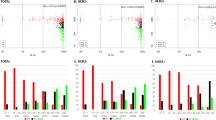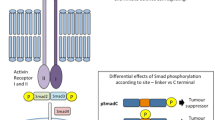Abstract
Introduction Changes in proliferation as measured by Ki67 occur within 14 days of starting treatment with an aromatase inhibitor and these changes have been shown to be predictors of long term outcome. This study aimed to compare changes in proliferation following 14 days of treatment with anastrozole and letrozole. Methods Two hundred and six women with 209 estrogen receptor (ER) positive operable breast cancers (three bilateral) were randomly allocated to receive either 14 days treatment with 2.5 mg of letrozole or 1 mg of anastrozole prior to surgery. Changes in expression of estrogen (ER) and progesterone receptors (PgR) as assessed by ALLRED scores and proliferation as assessed by Ki67 were analysed. The HER2 status of each tumour was also assessed using a combination of the Hercept test and FISH. Results Both letrozole and anastrozole reduced ER expression (ALLRED score) by a mean of 0.32 (0.20–0.44), P < 0.001 and PgR fell by a mean of 2.54 (2.20–2.89) P < 0.0001. Letrozole reduced proliferation from a geometric mean of 6.37% to 0.81%, P < 0.0001 and anastrozole reduced proliferation from 5.81% to 0.77%, P < 0.0001. There was no differences between drugs in the fall in ER, PgR or proliferation. Both letrozole and anastrozole produced significant falls in proliferation in both HER2 positive and HER2 negative cancers, all P < 0.001. Discussion 14 days of both letrozole and anastrozole reduces proliferation, ER and PgR expression. No significant difference between these two drugs was identified.
Similar content being viewed by others
References
Barnes DM, Millis RR, Billett CE et al (2004) The interaction of oestrogen receptor status and pathological features with adjuvant treatment in relation to survival in patients with operable breast cancer: a retrospective study of 2660 patients. Endocr Relat Cancer 11:85–96
Mourisden H, Gershanovich M, Sun Y et al (2001) Superior efficacy of letrozole versus tamoxifen as first-line therapy for postmenopausal women with advanced breast cancer: results of a phase III study of the International Letrozole Breast Cancer Group. J Clin Oncol 19:2596–2606
Smith IE, Dowsett M, Ebbs SR et al (2005) Neoadjuvant treatment of postmenopausal breast cancer with anastrozole, tamoxifen, or both in combination: the Immediate Preoperative Anastrozole, Tamoxifen or Combined with Tamoxifen (IMPACT) multicenter double-blind randomized trial. J Clin Oncol 23:5108–5116
Eiermann W, Paeple S, Appfelstaedt J et al (2001) Preoperative treatment of postmenopausal breast cancer patients with letrozole: a randomized double-blind multicenter study. Ann Oncol 12:1527–1532
Bonneterre J, Thurlimann B, Robertson JF et al (2000) Anastrozole versus tamoxifen as first-line therapy for advanced breast cancer in 668 postmenopausal women: results of the Tamoxifen or Arimidex Randomized Group Efficacy and Tolerability study. J Clin Oncol 18:3748–3757
Vergote I, Bonneterre J, Thurlimann B et al (2000) Randomised study of anastrozole versus tamoxifen as first-line therapy for advanced breast cancer in postmenopausal women. Eur J Cancer 36(suppl 4):S84–S85
Howell A, Cuzick J, Baum M et al (2005) Results of the ATAC (Arimidex, Tamoxifen, Alone or in Combination) trial after completion of 5 years’ adjuvant treatment for breast cancer. Lancet 365:60–62
Coates AS, Keshaviah A, Thurlimann B et al (2007) Five years of letrozole compared with tamoxifen as initial adjuvant therapy for postmenopausal women with endocrine-responsive early breast cancer: update of study BIG 1-98. J Clin Oncol 25:486–492
Dowsett M, Ebbs SR, Dixon JM et al (2005) Biomarker changes during neoadjuvant anastrozole, tamoxifen, or the combination: influence of hormonal status and HER-2 in breast cancer-a study from the IMPACT trialists. J Clin Oncol 23:2477–2492
Dowsett M, Smith IE, Ebbs SR et al (2005) Short-term changes in Ki-67 during neoadjuvant treatment of primary breast cancer with anastrozole or tamoxifen alone or combined correlate with recurrence-free survival. Clin Cancer Res 11:951s–958s
Murray E, Renshaw L, Macaskill EJ et al (2006) Factors predicting survival after neoadjuvant therapy with aromatase inhibitors. Breast Cancer Res Treat 100:S23
Llombart A, Ruiz A, Lopez-Guerrero JA et al (2006) Objective response to neoadjuvant letrozole predicts distant disease free survival in post-menopausal women with stage ii-iii ER/PgR positive breast cancer. Ann Oncol 17(suppl 9):ix96
Geisler J, Haynes B, Anker G (2002) Influence of letrozole and anastrozole on total body aromatization and plasma estrogen levels in postmenopausal breast cancer evaluated in a randomized, cross-over study. J Clin Oncol 20:751–757
Dixon JM, Renshaw L, Young O, Murray J, Macaskill EJ, McHugh M, Folkerd E, Cameron DA, A’Hern RP, Dowsett M (2008) Letrozole suppresses plasma estradiol and estrone sulphate more completely than anastrozole in postmenopausal women with breast cancer. J Clin Oncol 26:1671–1676
Miller WR, Dixon JM (2001) Local endocrine effects of aromatase inhibitors within the breast. J Steroid Biochem Mol Biol 79:93–102
Miller WR (1999) Biology of aromatase inhibitors: pharmacology/endocrinology within the breast. Endocr Relat Cancer 6:187–195
Gershanovich M, Chaudri HA, Campos D et al (1998) Letrozole, a new oral aromatase inhibitor: randomised trial comparing 2.5 mg daily, 0.5 mg daily and aminoglutethimide in postmenopausal women with advanced breast cancer. Letrozole International Trial Group (AR/BC3). Ann Oncol 9:639–645
Nabholtz JM, Buzdar A, Pollak M et al (2000) Anastrozole is superior to tamoxifen as first-line therapy for advanced breast cancer in postmenopausal women: results of a North American multicenter randomized trial. J Clin Oncol 18:3758–3767
Urruticoechea A, Smith IE, Dowsett M (2005) Proliferation marker Ki-67 in early breast cancer. J Clin Oncol 23:7212–7220
Robertson JF, Nicholson RI, Bundred NJ et al (2001) Comparison of the short -term biological effects of 7alpha- [9- (4, 4, 5, 5, 5- pentafluoropentylsulfinyl)-nonyl] estra-1, 3, 5, (10)-triene-3, 17 beta-diol (Faslodex) versus tamoxifen in postmenopausal women with primary breast cancer. Cancer Res 61:6739–6746
Werner M, Chott A, Fabiano A et al (2000) Effect of formalin tissue fixation and processing on immunohistochemistry. Am J Surg Pathol 24:1016–1019
Anderson TJ, Dixon JM, Murray J et al (2004) Early changes in tumour Ki67 expression differentiate for pathological (but not clinical) response in breast cancers treated neo-adjuvantly with letrozole. Breast Cancer Res Treat 78(suppl 1):S50
Ellis MJ, Tao Y, Luo J et al (2007) Outcome prediction for clinical stage II and III ER+ breast cancer based on treatment response, pathological stage, tumor grade, Ki67 proliferation index, and estrogen receptor status after neoadjuvant endocrine therapy. Breast Cancer Res Treat 106(suppl 1):S16
Ellis MJ, Tao Y, Young O et al (2006) Estrogen independent proliferation is present in the majority of estrogen receptor positive (ER+) HER2 gene amplified primary breast cancers after letrozole exposure despite frequent tumor regression during neoadjuvant treatment. J Clin Oncol 24(19):3019–3025
Author information
Authors and Affiliations
Corresponding author
Electronic Supplementary Material
Below is the link to the electronic supplementary material.
Rights and permissions
About this article
Cite this article
Murray, J., Young, O.E., Renshaw, L. et al. A randomised study of the effects of letrozole and anastrozole on oestrogen receptor positive breast cancers in postmenopausal women. Breast Cancer Res Treat 114, 495–501 (2009). https://doi.org/10.1007/s10549-008-0027-0
Received:
Accepted:
Published:
Issue Date:
DOI: https://doi.org/10.1007/s10549-008-0027-0




